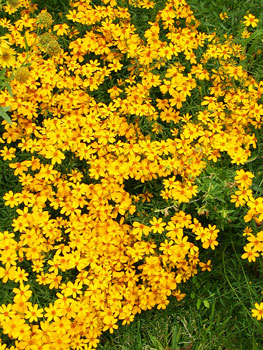Copper Canyon Daisy
Tagetes lemmonii
for an aromatic summer green that explodes into autumn gold

Common Names: Copper Canyon Daisy, Lemmon's Marigold
Latin Name: Tagetes lemmonii
Design Tip: Use in the border with fall flower colors of blues and purples from such plants as native asters, Mexican bush sage or Maximilian daisies. When off the bloom, its soft domed form contrasts well against strong architectural plants such as spiky yuccas.
Form: The shrubby herbaceous perennial attains a naturally rounded mound, 2'-4' tall and wide.
Flowers: One-inch, bright golden-yellow daisy flowers smother the foliage in fall, until frost. Some strains may produce a light spring bloom when allowed to develop without pruning in spring. In frost-free regions, they will bloom constantly throughout the short-day seasons.
Foliage: The bright green, filigreed green leaves release a strong fruity-woodsy smell, even when lightly touched.
Soil: While drought-tolerant on thin alkaline soil in the wilds, better blooms and plant density are produced in moist, well-drained cultivated beds.
Light Exposure: Native to Mexico and the Southwest U.S. states, this sun-lover is a candidate for the hottest site in the garden.
Hardiness: The Metroplex is on the cusp of the plant's Zone 7-8 limits, where its roots can survive a mild winter under a protective mulch. Although the stems and foliage finish with a 25F frost, it soon returns in spring.
Grooming: Once frost-bitten, the finished stems should be pruned close to the ground and freshly mulched. Some strains may produce a light bloom in spring, after which they can be sheared by one third in early summer to encourage a denser mound of autumn bloom.
Propagation: Related to the annual garden marigold, this perennial Tagettes marigold can be easily propagated by seeds or by rooting stem cuttings, or by dividing root clumps in the spring.
Tidbits: The aromatic foliage is often described as citrus-like, or as having anise or licorice tones, depending on the narrator's nose. The strong fragrance seems to be either loved or hated by humans, but more consistently disliked by foraging deer. Unlike the fancier annual marigolds, this scented plant is not susceptible to spider mites, but does attract migrating butterflies and beneficial insects. The lemmonii name refers to the plants discoverer, Californian botanist, John Gill Lemmon (1832-1908), and not for its citrus-like scent.
Cultivated, photographed and written by
Maggie Ross McNeely in Ft. Worth, Texas
All rights reserved